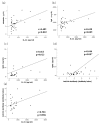Impact of interleukin-21 in the pathogenesis of primary Sjögren's syndrome: increased serum levels of interleukin-21 and its expression in the labial salivary glands
- PMID: 22030011
- PMCID: PMC3308114
- DOI: 10.1186/ar3504
Impact of interleukin-21 in the pathogenesis of primary Sjögren's syndrome: increased serum levels of interleukin-21 and its expression in the labial salivary glands
Abstract
Introduction: Interleukin (IL)-21 is a cytokine that controls the functional activity of effector T helper cells and the differentiation of Th17 cells, and promotes B-cell differentiation. To test whether IL-21 participates in the pathogenesis of primary Sjögren's syndrome (SS), serum IL-21 level was measured and IL-21 expression in the labial salivary glands (LSG) was examined.
Methods: Serum IL-21 levels in 40 primary SS, 40 rheumatoid arthritis (RA), and 38 systemic lupus erythematosus (SLE) patients and 20 healthy controls were measured. Serum IL-21 levels of SS patients were assessed for correlations with laboratory data, including anti-nuclear antibody, anti-Ro/La antibodies, globulin, immunoglobulin (Ig) class, and IgG subclass. LSGs from 16 primary SS and 4 controls with sicca symptoms were evaluated for IL-21 and IL-21 receptor (IL-21R) expression by immunohistochemistry. Confocal microscopy was performed to further characterize the IL-21 positive cells.
Results: Primary SS patients had significantly higher serum IL-21 levels than controls, and these increments correlated positively with levels of IgG, IgG1. Serum IgG1 levels correlated with anti-Ro antibody titers. Immunohistochemical analyses showed that lymphocytic foci and the periductal area of the LSGs from SS patients expressed high levels of IL-21 and lower levels of IL-21R, whereas the control LSGs showed minimal expression of both antigens. The more the lymphocyte infiltrated, IL-21 expression in LSGs showed a tendency to increase. Confocal microscopic analyses revealed that IL-21 expressing infiltrating lymphocytes in the LSGs of SS patients also expressed CXCR5.
Conclusions: Primary SS is associated with high serum IL-21 levels that correlate positively with serum IgG, especially IgG1, levels. The expression of IL-21 is increased as more lymphocytes infiltrated in LSGs. These observations suggest that IL-21 may play an important role in primary SS pathogenesis.
Figures





Comment in
-
IL-21 and Sjögren's syndrome.Arthritis Res Ther. 2011;13(6):137. doi: 10.1186/ar3518. Epub 2011 Dec 19. Arthritis Res Ther. 2011. PMID: 22226370 Free PMC article.
References
-
- Coquet JM, Kyparissoudis K, Pellicci DG, Besra G, Berzins SP, Smyth MJ, Godfrey DI. IL-21 is produced by NKT cells and modulates NKT cell activation and cytokine production. J Immunol. 2007;178:2827–2834. - PubMed
Publication types
MeSH terms
Substances
LinkOut - more resources
Full Text Sources
Other Literature Sources
Medical
Research Materials

